Na Yi
Sherman-Morrison Regularization for ELAA Iterative Linear Precoding
Jan 26, 2023



Abstract:The design of iterative linear precoding is recently challenged by extremely large aperture array (ELAA) systems, where conventional preconditioning techniques could hardly improve the channel condition. In this paper, it is proposed to regularize the extreme singular values to improve the channel condition by deducting a rank-one matrix from the Wishart matrix of the channel. Our analysis proves the feasibility to reduce the largest singular value or to increase multiple small singular values with a rank-one matrix when the singular value decomposition of the channel is available. Knowing the feasibility, we propose a low-complexity approach where an approximation of the regularization matrix can be obtained based on the statistical property of the channel. It is demonstrated, through simulation results, that the proposed low-complexity approach significantly outperforms current preconditioning techniques in terms of reduced iteration number for more than $10\%$ in both ELAA systems as well as symmetric multi-antenna (i.e., MIMO) systems when the channel is i.i.d. Rayleigh fading.
Constellation-Oriented Perturbation for Scalable-Complexity MIMO Nonlinear Precoding
Aug 04, 2022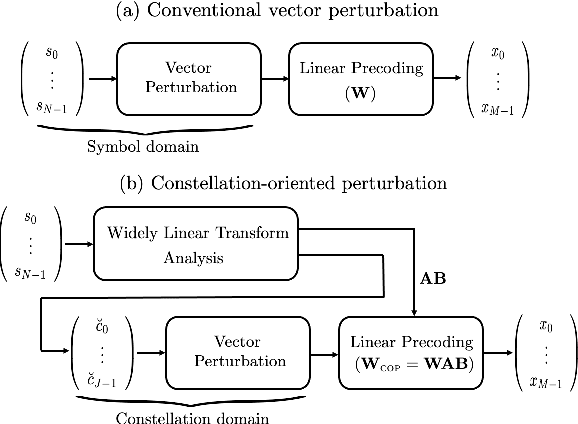
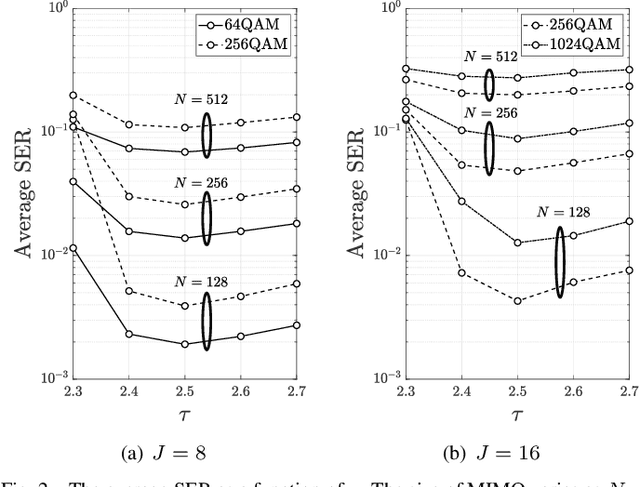
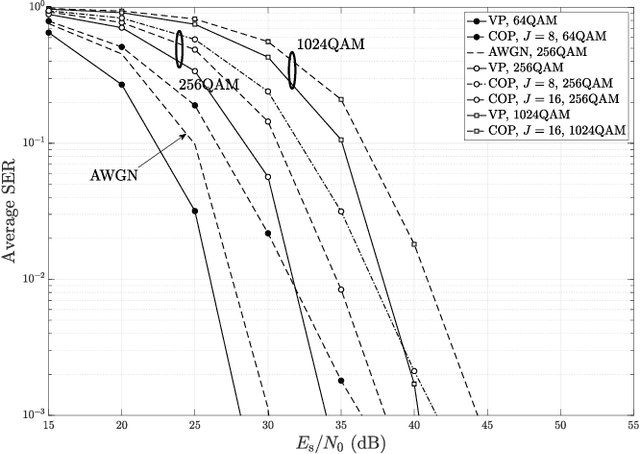
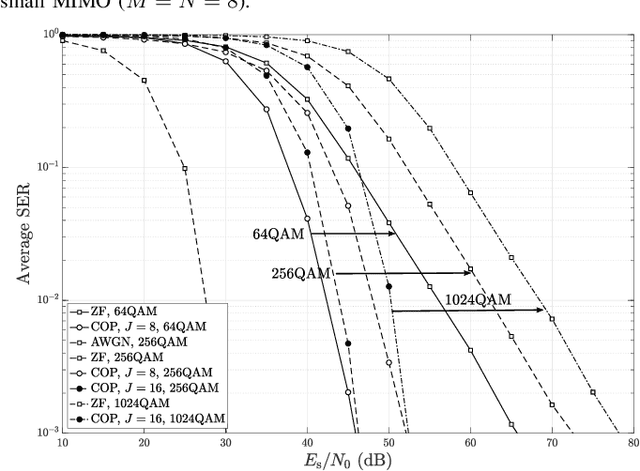
Abstract:In this paper, a novel nonlinear precoding (NLP) technique, namely constellation-oriented perturbation (COP), is proposed to tackle the scalability problem inherent in conventional NLP techniques. The basic concept of COP is to apply vector perturbation (VP) in the constellation domain instead of symbol domain; as often used in conventional techniques. By this means, the computational complexity of COP is made independent to the size of multi-antenna (i.e., MIMO) networks. Instead, it is related to the size of symbol constellation. Through widely linear transform, it is shown that COP has its complexity flexibly scalable in the constellation domain to achieve a good complexity-performance tradeoff. Our computer simulations show that COP can offer very comparable performance with the optimum VP in small MIMO systems. Moreover, it significantly outperforms current sub-optimum VP approaches (such as degree-2 VP) in large MIMO whilst maintaining much lower computational complexity.
Power Allocation for FDMA-URLLC Downlink with Random Channel Assignment
Aug 04, 2022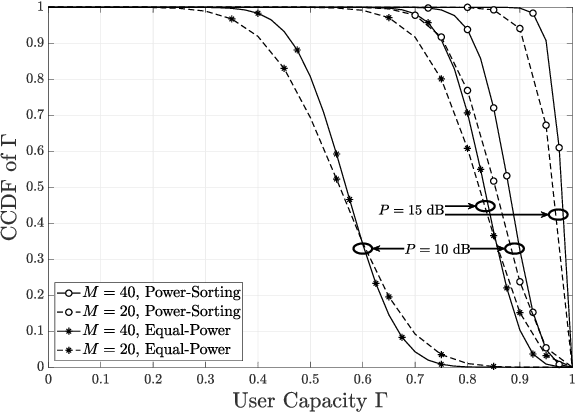
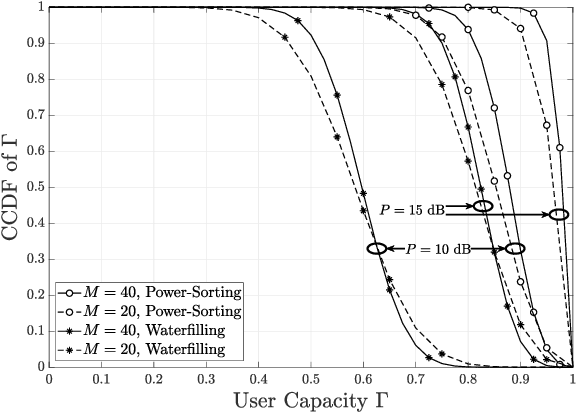
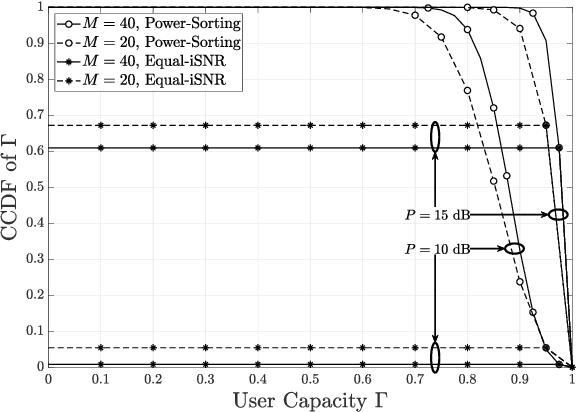
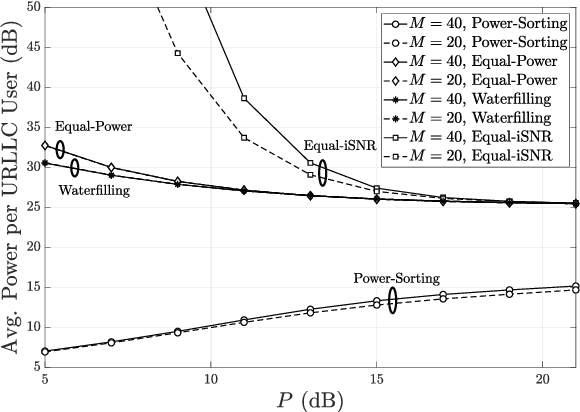
Abstract:Concerning ultra-reliable low-latency communication (URLLC) for the downlink operating in the frequency-division multiple-access with random channel assignment, a lightweight power allocation approach is proposed to maximize the number of URLLC users subject to transmit-power and individual user-reliability constraints. Provided perfect channel-state-information at the transmitter (CSIT), the proposed approach is proven to ensure maximized URLLC users. Assuming imperfect CSIT, the proposed approach still aims to maximize the URLLC users without compromising the individual user reliability by using a pessimistic evaluation of the channel gain. It is demonstrated, through numerical results, that the proposed approach can significantly improve the user capacity and the transmit-power efficiency in Rayleigh fading channels. With imperfect CSIT, the proposed approach can still provide remarkable user capacity at limited cost of transmit-power efficiency.
Network-ELAA Beamforming and Coverage Analysis for eMBB/URLLC in Spatially Non-Stationary Rician Channels
Jan 19, 2022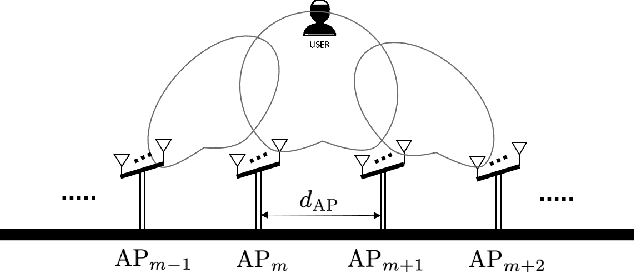
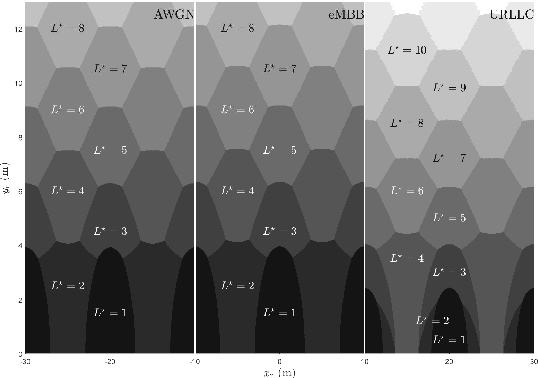
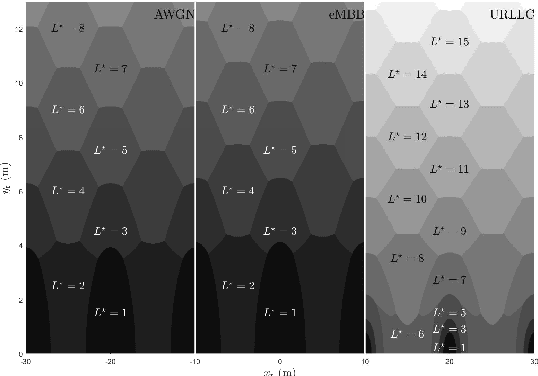
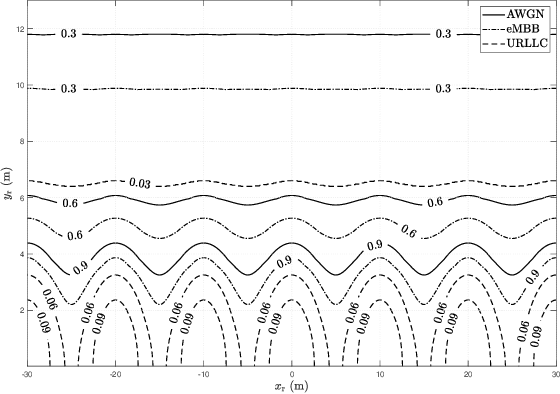
Abstract:In vehicle-to-infrastructure (V2I) networks, a cluster of multi-antenna access points (APs) can collaboratively conduct transmitter beamforming to provide data services (e.g., eMBB or URLLC). The collaboration between APs effectively forms a networked linear antenna-array with extra-large aperture (i.e., network-ELAA), where the wireless channel exhibits spatial nonstationarity. Major contribution of this work lies in the analysis of beamforming gain and radio coverage for network-ELAA non-stationary Rician channels considering the AP clustering. Assuming that: 1) the total transmit-power is fixed and evenly distributed over APs, 2) the beam is formed only based on the line-of-sight (LoS) path, it is found that the beamforming gain is concave to the cluster size. The optimum size of the AP cluster varies with respect to the user's location, channel uncertainty as well as data services. A user located farther from the ELAA requires a larger cluster size. URLLC is more sensitive to the channel uncertainty when comparing to eMBB, thus requiring a larger cluster size to mitigate the channel fading effect and extend the coverage. Finally, it is shown that the network-ELAA can offer significant coverage extension (50% or more in most of cases) when comparing with the single-AP scenario.
Massive-MIMO MF Beamforming with or without Grouped STBC for Ultra-Reliable Single-Shot Transmission Using Aged CSIT
Oct 06, 2021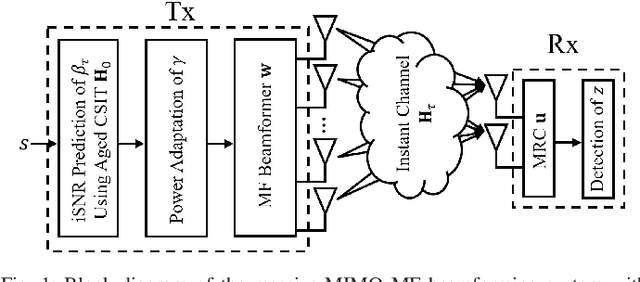
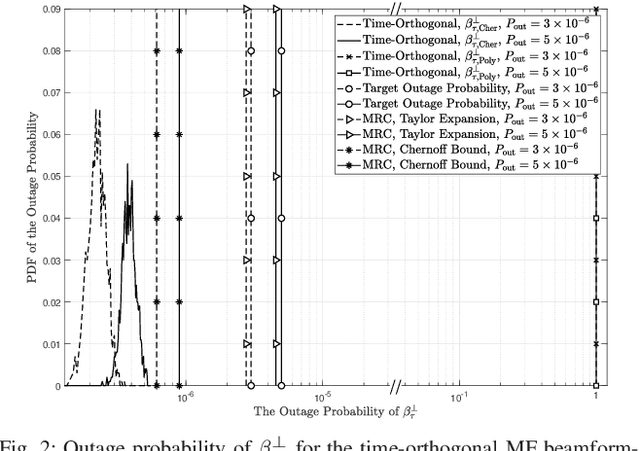
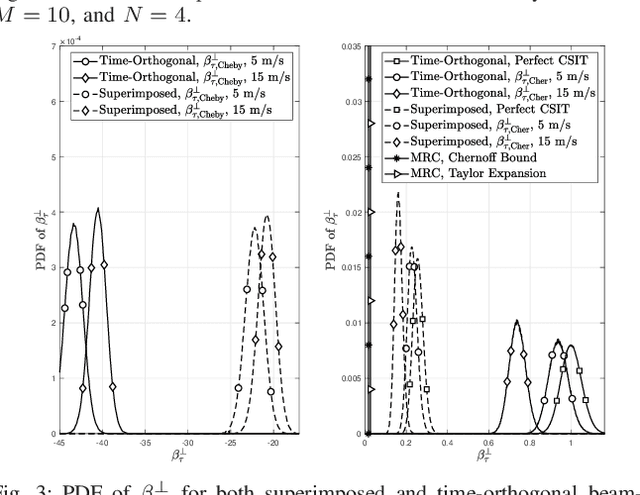
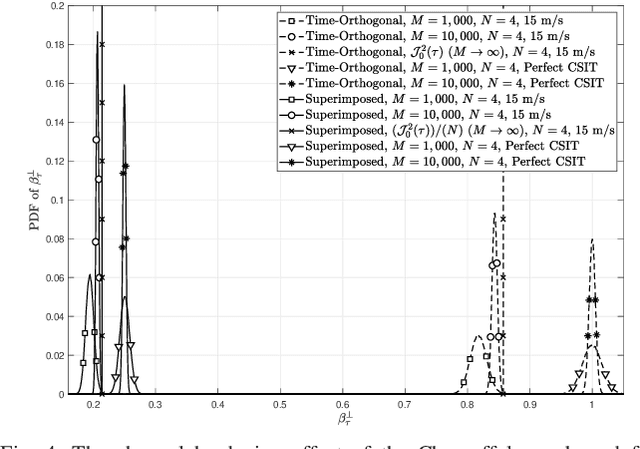
Abstract:The technology of using massive transmit-antennas to enable ultra-reliable single-shot transmission (URSST) is challenged by the transmitter-side channel knowledge (i.e., CSIT) imperfection. When the imperfectness mainly comes from the channel time-variation, the outage probability of the matched filter (MF) transmitter beamforming is investigated based on the first-order Markov model of the aged CSIT. With a fixed transmit-power, the transmitter-side uncertainty of the instantaneous signal-to-noise ratio (iSNR) is mathematically characterized. In order to guarantee the outage probability for every single shot, a transmit-power adaptation approach is proposed to satisfy a pessimistic iSNR requirement, which is predicted using the Chernoff lower bound of the beamforming gain. Our numerical results demonstrate a remarkable transmit-power efficiency when comparing with power control approaches using other lower bounds. In addition, a combinatorial approach of the MF beamforming and grouped space-time block code (G-STBC) is proposed to further mitigate the detrimental impact of the CSIT uncertainty. It is shown, through both theoretical analysis and computer simulations, that the combinatorial approach can further improve the transmit-power efficiency with a good tradeoff between the outage probability and the latency.
Hermite Expansion Model and LMMSE Analysis for Low-Resolution Quantized MIMO Detection
Sep 11, 2021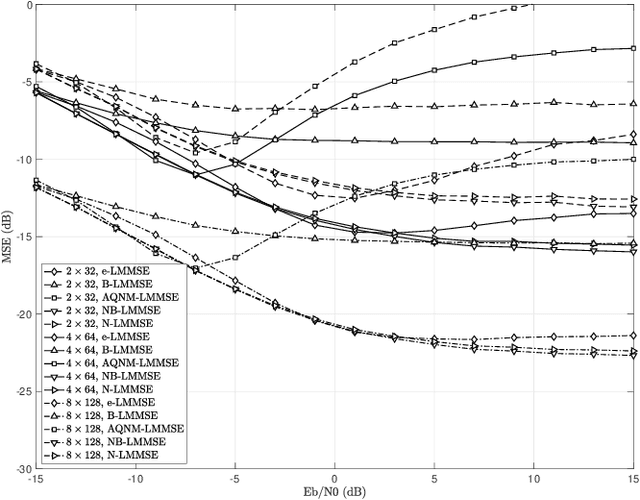
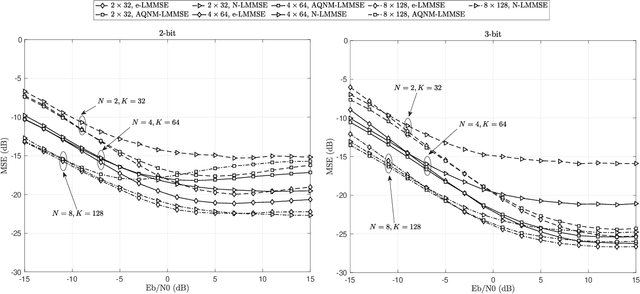
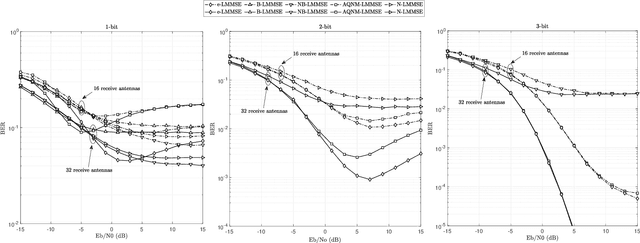
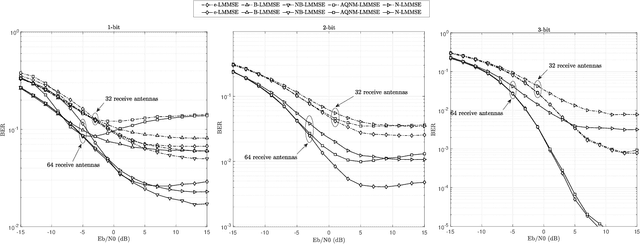
Abstract:In this paper, the Hermite polynomials are employed to study linear approximation models of narrowband multiantenna signal reception (i.e., MIMO) with low-resolution quantizations. This study results in a novel linear approximation using the second-order Hermite expansion (SOHE). The SOHE model is not based on those assumptions often used in existing linear approximations. Instead, the quantization distortion is characterized by the second-order Hermite kernel, and the signal term is characterized by the first-order Hermite kernel. It is shown that the SOHE model can explain almost all phenomena and characteristics observed so far in the low-resolution MIMO signal reception. When the SOHE model is employed to analyze the linear minimum-mean-square-error (LMMSE) channel equalizer, it is revealed that the current LMMSE algorithm can be enhanced by incorporating a symbol-level normalization mechanism. The performance of the enhanced LMMSE algorithm is demonstrated through computer simulations for narrowband MIMO systems in Rayleigh fading channels.
* 16 pages
A Non-Stationary Channel Model with Correlated NLoS/LoS States for ELAA-mMIMO
Aug 18, 2021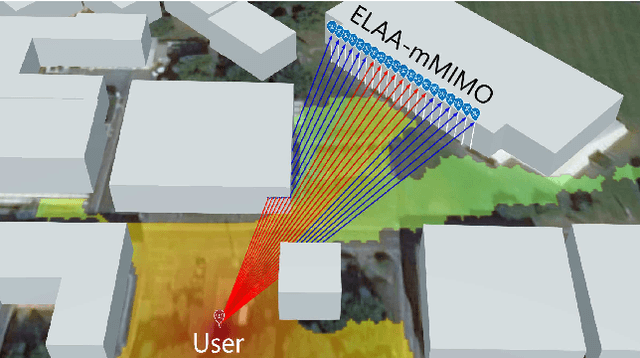
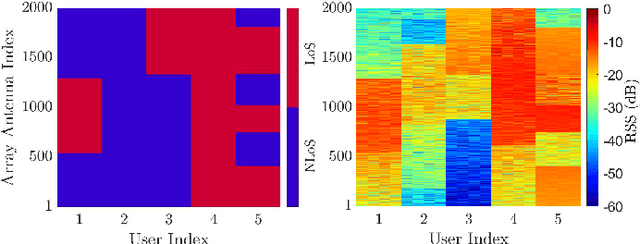
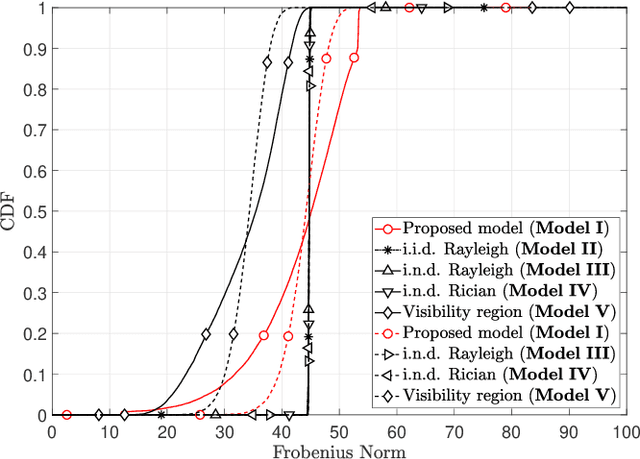
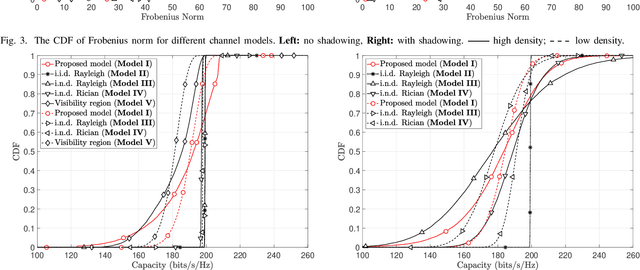
Abstract:In this paper, a novel spatially non-stationary channel model is proposed for link-level computer simulations of massive multiple-input multiple-output (mMIMO) with extremely large aperture array (ELAA). The proposed channel model allows a mix of non-line-of-sight (NLoS) and LoS links between a user and service antennas. The NLoS/LoS state of each link is characterized by a binary random variable, which obeys a correlated Bernoulli distribution. The correlation is described in the form of an exponentially decaying window. In addition, the proposed model incorporates shadowing effects which are non-identical for NLoS and LoS states. It is demonstrated, through computer emulation, that the proposed model can capture almost all spatially non-stationary fading behaviors of the ELAA-mMIMO channel. Moreover, it has a low implementational complexity. With the proposed channel model, Monte-Carlo simulations are carried out to evaluate the channel capacity of ELAA-mMIMO. It is shown that the ELAA-mMIMO channel capacity has considerably different stochastic characteristics from the conventional mMIMO due to the presence of channel spatial non-stationarity.
End-to-End Learning for Uplink MU-SIMO Joint Transmitter and Non-Coherent Receiver Design in Fading Channels
May 04, 2021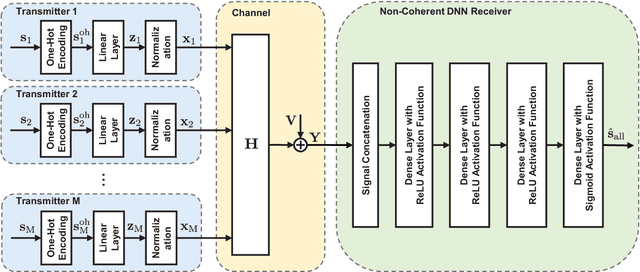
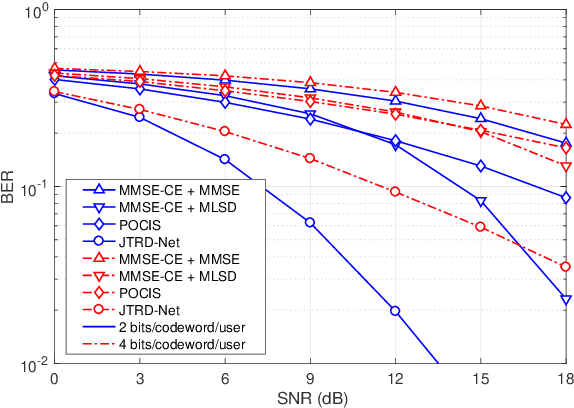
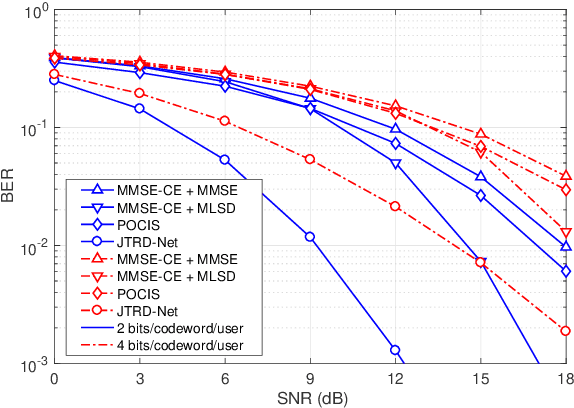
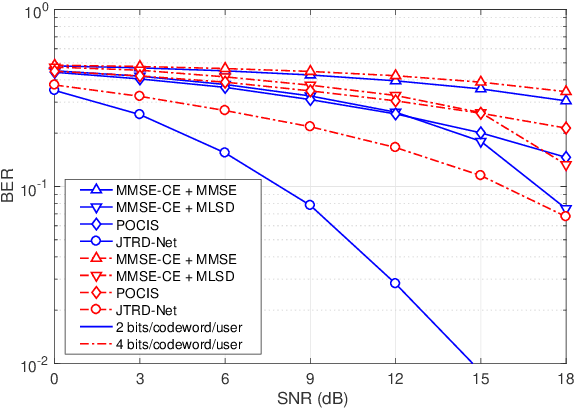
Abstract:In this paper, a novel end-to-end learning approach, namely JTRD-Net, is proposed for uplink multiuser single-input multiple-output (MU-SIMO) joint transmitter and non-coherent receiver design (JTRD) in fading channels. The basic idea lies in the use of artificial neural networks (ANNs) to replace traditional communication modules at both transmitter and receiver sides. More specifically, the transmitter side is modeled as a group of parallel linear layers, which are responsible for multiuser waveform design; and the non-coherent receiver is formed by a deep feed-forward neural network (DFNN) so as to provide multiuser detection (MUD) capabilities. The entire JTRD-Net can be trained from end to end to adapt to channel statistics through deep learning. After training, JTRD-Net can work efficiently in a non-coherent manner without requiring any levels of channel state information (CSI). In addition to the network architecture, a novel weight-initialization method, namely symmetrical-interval initialization, is proposed for JTRD-Net. It is shown that the symmetrical-interval initialization outperforms the conventional method (e.g. Xavier initialization) in terms of well-balanced convergence-rate among users. Simulation results show that the proposed JTRD-Net approach takes significant advantages in terms of reliability and scalability over baseline schemes on both i.i.d. complex Gaussian channels and spatially-correlated channels.
On Deep Learning Solutions for Joint Transmitter and Noncoherent Receiver Design in MU-MIMO Systems
Apr 14, 2020
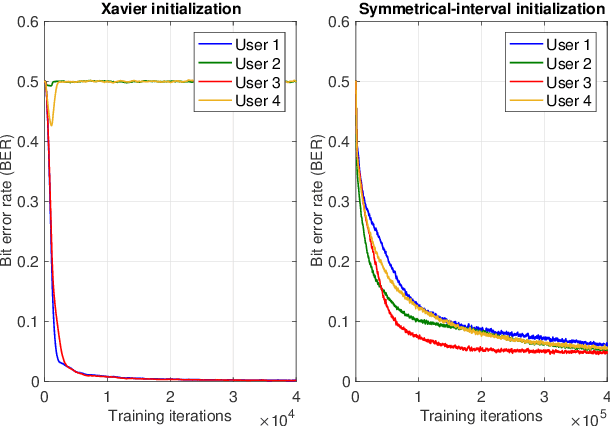
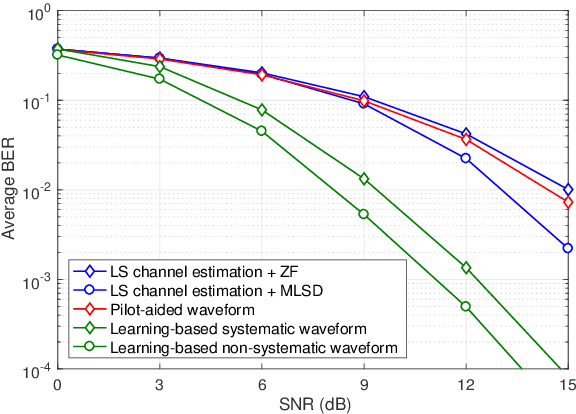

Abstract:This paper aims to handle the joint transmitter and noncoherent receiver design for multiuser multiple-input multiple-output (MU-MIMO) systems through deep learning. Given the deep neural network (DNN) based noncoherent receiver, the novelty of this work mainly lies in the multiuser waveform design at the transmitter side. According to the signal format, the proposed deep learning solutions can be divided into two groups. One group is called pilot-aided waveform, where the information-bearing symbols are time-multiplexed with the pilot symbols. The other is called learning-based waveform, where the multiuser waveform is partially or even completely designed by deep learning algorithms. Specifically, if the information-bearing symbols are directly embedded in the waveform, it is called systematic waveform. Otherwise, it is called non-systematic waveform, where no artificial design is involved. Simulation results show that the pilot-aided waveform design outperforms the conventional zero forcing receiver with least squares (LS) channel estimation on small-size MU-MIMO systems. By exploiting the time-domain degrees of freedom (DoF), the learning-based waveform design further improves the detection performance by at least 5 dB at high signal-to-noise ratio (SNR) range. Moreover, it is found that the traditional weight initialization method might cause a training imbalance among different users in the learning-based waveform design. To tackle this issue, a novel weight initialization method is proposed which provides a balanced convergence performance with no complexity penalty.
A Modular Neural Network Based Deep Learning Approach for MIMO Signal Detection
Apr 01, 2020
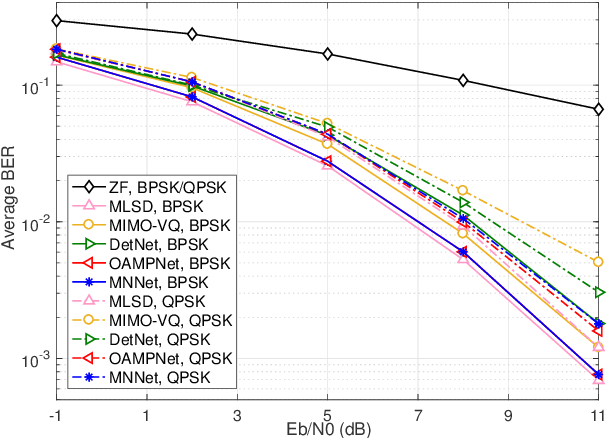


Abstract:In this paper, we reveal that artificial neural network (ANN) assisted multiple-input multiple-output (MIMO) signal detection can be modeled as ANN-assisted lossy vector quantization (VQ), named MIMO-VQ, which is basically a joint statistical channel quantization and signal quantization procedure. It is found that the quantization loss increases linearly with the number of transmit antennas, and thus MIMO-VQ scales poorly with the size of MIMO. Motivated by this finding, we propose a novel modular neural network based approach, termed MNNet, where the whole network is formed by a set of pre-defined ANN modules. The key of ANN module design lies in the integration of parallel interference cancellation in the MNNet, which linearly reduces the interference (or equivalently the number of transmit-antennas) along the feed-forward propagation; and so as the quantization loss. Our simulation results show that the MNNet approach largely improves the deep-learning capacity with near-optimal performance in various cases. Provided that MNNet is well modularized, the learning procedure does not need to be applied on the entire network as a whole, but rather at the modular level. Due to this reason, MNNet has the advantage of much lower learning complexity than other deep-learning based MIMO detection approaches.
 Add to Chrome
Add to Chrome Add to Firefox
Add to Firefox Add to Edge
Add to Edge